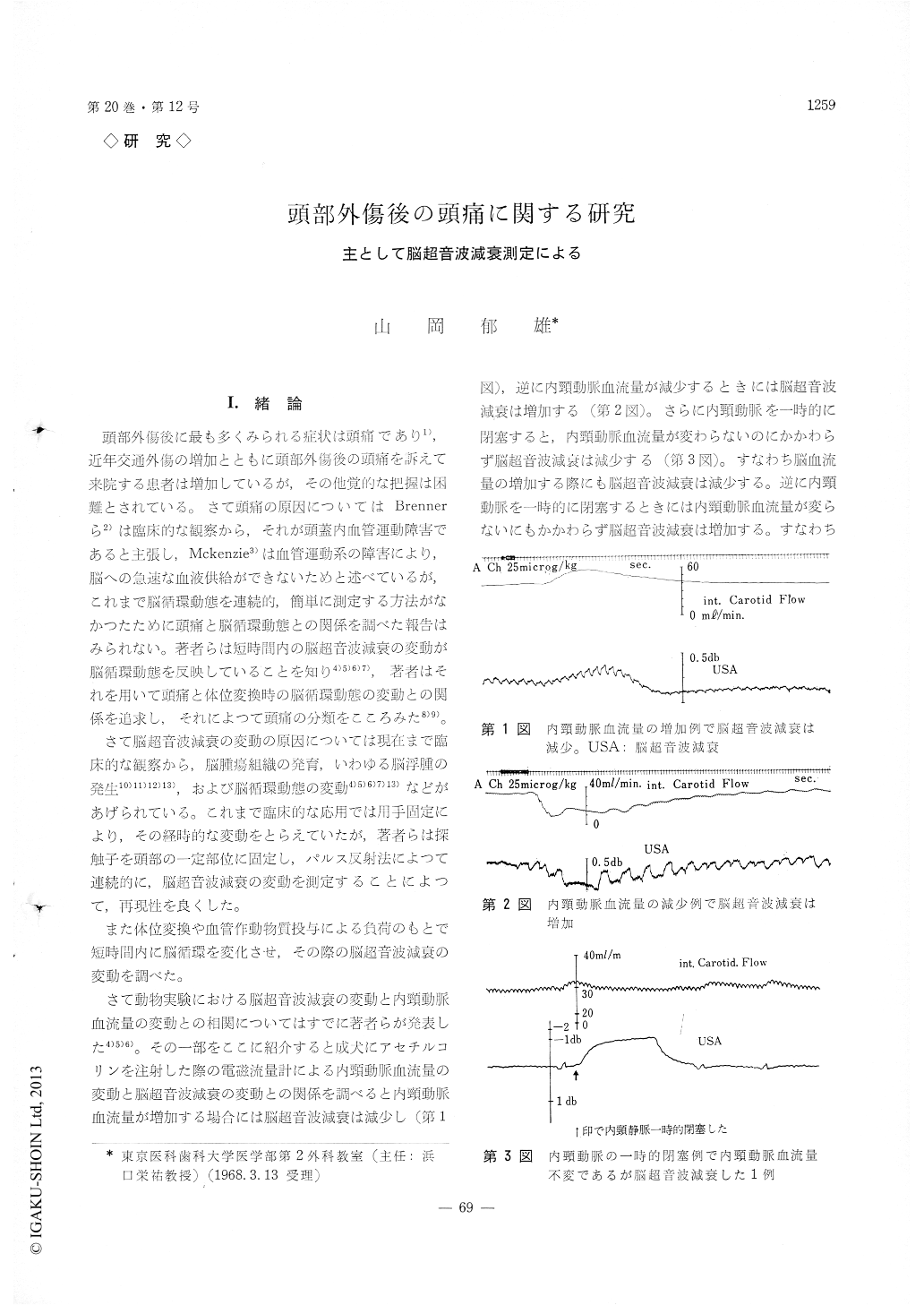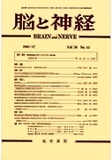Japanese
English
- 有料閲覧
- Abstract 文献概要
- 1ページ目 Look Inside
I.緒論
頭部外傷後に最も多くみられる症状は頭痛であり1),近年交通外傷の増加とともに頭部外傷後の頭痛を訴えて来院する患者は増加しているが,その他覚的な把握は困難とされている。さて頭痛の原因についてはBrennerら2)は臨床的な観察から,それが頭蓋内血管運動障害であると主張し,Mckenzie3)は血管運動系の障害により,脳への急速な血液供給ができないためと述べているが,これまで脳循環動態を連続的,簡単に測定する方法がなかったために頭痛と脳循環動態との関係を調べた報告はみられない。著者らは短時間内の脳超音波滅衰の変動が脳循環動態を反映していることを知り4)5)6)7),著者はそれを用いて頭痛と体位変換時の脳循環動態の変動との関係を追求し,それによつて頭痛の分類をこころみた8)9)。
さて脳超音波減衰の変動の原因については現在まで臨床的な観察から,脳腫瘍組織の発育,いわゆる脳浮腫の発生10)11)12)13),および脳循環動態の変動4)5)6)7)13)などがあげられている。これまで臨床な応用では用手固定により,その経時的な変動をとらえていたが,著者らは探触子を頭部の一定部位に固定し,パルス反射法によつて連続的に,脳超音波減衰の変動を測定することによつて,再現性を良くした。
Application of the fact that cerebral ultrasonic attenuation (CUSA) changes in accordance with blood flow change of the brain in animal experimental study, revealed out the relationship of the post-traumatic headache and the change of cerebral cir-culatory dynamics.
An ultrasonic convexed type transducer of 1 megacycle, 10 mm Φ, 30 mm R was fixed on the patient's forehead by elastic bandage. Using an x-ray table, I observed CUSA of patients continuously by ultrasonic pulse reflection method while the pa-tients were moved from spine to 65 degree tilted position and back to spine position.
In normal person, CUSA increased in accordance with the postural change from lying to standing position, in other words, cerebral blood flow decreased (Type A). On the other hand, case of abnormal circulatory dynamic reaction showed decrease of by tilting the bodies (Type B).
(1) May of the patients with posttraumatic head-ache showed type B.
(2) Cases of migrain showed B type reaction on the side of headache.
(3) The type B group was further classified into cerebral vasospastic type, cerebral vasodila-tated type, cerebral vasoparalytic type cerebral vasoparalytic type and non vascular headache by measuring CUSA change with the postural change, before and after using oral tablet of Isosorbide Dinitrate (Nitorol).
According to this ultrasonic new classification :
(4) All of 14 cases with migrain were vascular headache and vasodilatated type (64%) was twice as much as vasospastic type (36%).
(5) In 92 cases of craniotraumatic headache, 10% of them were nonvascular headache. In the vascular headache, more vasospastic type (50%) was found than vasodilatated type (40%).
(6) On the contrary, in cases of cervical syn-drom vascular headache was 28% more than in the cases of head trauma and more vaso-dilatated type (46%) was found than vaso-spastic type (28%).
(7) In these diseases, the longer their clinical history, the more cerebral vasodilated type was seen and the less was the cerebral vasospastic type.
(8) By following such cases of type B, I found that type B became type A with diminishing of the complaints. Most of the posttraumatic headache, vasospastic type changed to vaso-dilatated type and then returned to normal condition or directly recover to normal type, but some of the patients remain to cerebral vasodilatated type and followed chronic clinical course.
Thus, I set up new classification of headache ac-cording to the measurement of CUSA change. There were difference of types of headache among migrain, posttraumatic and cervical syndrom group. Adequate therapy to each group classified by this method lead to better therapeutic results, so I con-sider this classification and the method are reasonable.

Copyright © 1968, Igaku-Shoin Ltd. All rights reserved.


